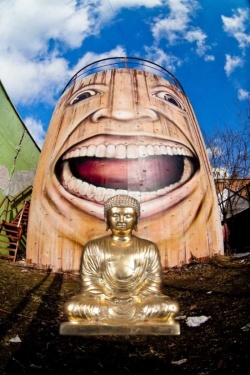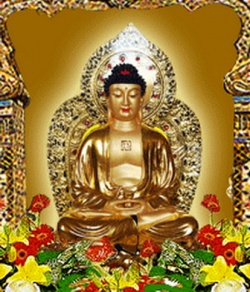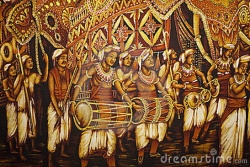Khandro Dayig – The Dakini Script
During Guru Padmasambhava’s lifetime, he interred countless revelatory treasures known as terma in Bhutan. These treasures were concealed in different landscapes to help keep the Buddhist doctrine pure and responsive to the needs of the times.
The 8th century, tantric master composed many gonters or mind treasures and embedded these secret teachings in the realm of mind and space for posterity to be discovered centuries later.
The advanced secret teachings were recorded in secret codes known as Khando Dayig or the Dakini script.
Dakinis are female guardians of esoteric teachings and play key role in tantric Buddhism.
Only the realized masters such as the Tertöns or “Treasure Revealers” can reveal these treasures. But only a few of them have the power and knowledge to unfold the mind treasures into whole teachings.
The Dakini script looks mystical, but is for real although the art of writing and reading may have disappeared.
Some scholars say it resembles a more cursive deviation of the Dzongkha fonts while others say that is a variant of classical Tibetan.
Some even argue that it resembles the Sufi calligraphy of the Islamic world. To the untrained eye, the script looks like an incomprehensible scribble.
The script of the sky dancers is a work of art. It can be compared to the best Japanese or Chinese calligraphy. The way the letters connect to each other, and how the letters appear to dance across the page can make a dissertation for a doctorate student. Some examples are more fluid and abstract.
Although nothing is certain, it is commonly believed that they are two types of Khandro Dayig. The first ones are those written by Guru and the second, those written by Tertöns while receiving the hidden teachings.
Some ancient texts describe Guru’s handwriting as, “thin and ravishingly beautiful.” Other scripts are considered to be thick and smooth or big but both scripts are effectual in composition.
Irrespective of the version of the script, the mystical writings look beautiful and form an exciting calligraphy. The fonts are designed in free hand calligraphy. An added mystery is that because the script could be a mix of several languages, some characters can be recognized, and parts of it may be understandable.
It is believed that Tertöns will see the seed texts or other symbolic clues in a dream or in the sky and even in waterfalls where the script appear. The script will remain until the treasure revealer reproduces the full text.
While Tertöns are expected to reveal gongters, not all have the realization to decipher the secret teachings.
Only the destined Tertöns will be able to apprehend the full meaning and decode the complete text. For example, Tertön Sherub Membar (1375-1435) revealed some Dakini script in Bhutan but could not decipher it. He had to seek the assistance of Tertön Dorji Lingpa (1346-1405) who could unfold the hidden teachings.
According to oral tradition explained by Lopen Kunzang Thinley, 65, one of the few people with some knowledge of the script, Dorji Lingpa knew about 14 languages ( or scripts ) and that could have helped him decipher the codes.
Tertöns are found to be amongst the ranks of lamas and sages whose high spiritual standing is already established. Occasionally a layman and even an unschooled person can find himself or herself to be the vehicle for this inspired activity.
Buddhists consider the Khando Dayig as one of the thongdrols or ‘liberation upon sight’. In Buddhist tradition, some things are so holy that just the mere sight of them plants seeds in our consciousness that will develop into the cause of our final freedom.
Tertön Mingyur Dorje (1645-1667), one of the treasure revealers of the 17th Century, endorsed this theory: “Those who see this script will not experience the three lower realms and will be liberated from the fear of falling into those realms; will be purified of the five poisons and freed from the results of one’s karma; will be freed from the fear of remaining in samsara.”
Bhutan might be one of the few places left in the world where physical treasures with Khando Dayig may be found.
According to Lopen Kunzang, the remote village of Nabji in south central Bhutan has Dakini scripts engraved on two stone pillars.
According to the scholar, Nabji is one of the first places Guru visited in Bhutan. The village is a pilgrimage site and the villagers consider the script as thongdrol.
Tertön Sangye Lingpa (1340-1396) revealed the Lama Gongdu Thongdrol Khorlo Kyilkhor or the “Wheel of the Embodiment of the Master’s Realization Mandala” from the [[Lama Gondu Cycle of Teaching. The late Dilgo Khyentse (1910-1991) had instructed Gelong Nyabchi to find this terma and place it above the Guru Nangsid Zilnön statue in Kyichu Monastery in Paro.
Lopen Nyabchi looked for it in all our monasteries but could not find it. One day, the Lopen accompanied the Royal Grandmother, to Dechenphu monastery. In the monastery, Her Majesty instructed Lopen to clean the principal Guru statue. While Lopen was cleaning it, he discovered a scroll of this Mandala behind the statue. Later, Lopen Pema Tshewang (Pemala) wrote down the golden secret Dakini script from the scroll.
Tertön Pema Lingpa works also contain many Dakini scripts. In 1976, Her Majesty the senior Queen of the 2nd King, Ashi Phuntsho Choeden sponsored the printing of the complete works by this Tertön. H.H. Dudjom Rinpoch did the proof reading and found many sample of Khando Dayig.
In 1968, Chögyam Trungpa (1939-1987) revealed the mind treasure “The Sadhana of Mahamudra” at Taktsang monastery in Bhutan. It is said that there are many terma sites in Bhutan, which hold treasure teachings of body, speech, mind, knowledge and activity – each supposedly distinct from the other – and that Bhutan is full of yellow scrolls, which contain terma texts in Dakini script.
In the tantric world treasures are hidden for posterity. Teachings are kept secret and the issue of empirical proof occupies a subsidiary importance. By nature, independent verification of their contents is impossible.
In the objective sense the terma texts are largely the work of the Tertöns themselves. Apart from the texts, which are recovered in complete form, most of the documents appear at best to be mere fragments and remnants of ancient writing.
The Bhutanese culture considers terma tradition to be important, precious, and above all, effective, as spiritual teachings hidden by Guru Rimpoche to be revealed at an appropriate time to benefit sentient beings
Conclusion
In the Himalayan ritual arts, the 8th century mystic, Guru Rinpoche is supreme. Today there is hardly anyone who can read the Dakini script.
The magical enigmatic script is a testimony to the fact that we possess innate magical qualities of the phenomenal world in all their limitless variety. Guru represents Buddhahood and is the symbol of what we hope to become and how to unlock what we already have within us. Regardless of religion, the Khando Dayig is the inspiration of how we can decode our true potential that that we are seeking in all spiritual forms.
Contributed by Tshering Tashi
Source
http://kuenselonline.com/archive/khandro-dayig-the-dakini-script/




